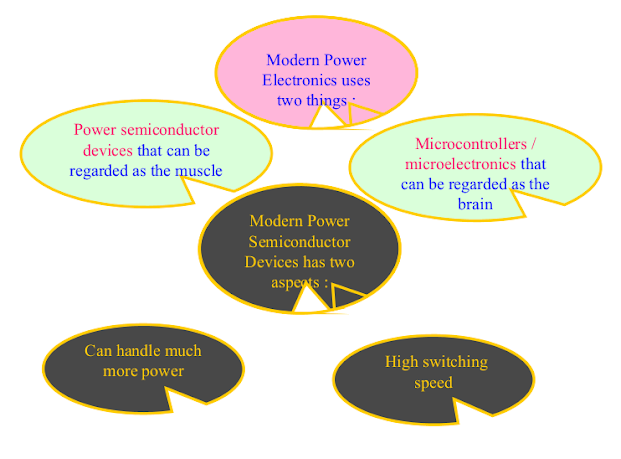What is Power Electronics?
An AC/DC converter (rectifier) is the most typical power electronics device found in many consumer electronic devices, e.g. television sets, personal computers, battery chargers, etc. The power range is typically from tens of watts to several hundred watts.
In industry a common application is the variable speed drive (VSD) that is used to control an induction motor. The power range of VSDs start from a few hundred watts and end at tens of megawatts.
Power Electronics involves the study of
• Power semiconductor devices - their physics, characteristics, drive requirements and their protection for optimum utilization of their capacities.
• Power converter topologies.
• Control strategies of the converters.
• Digital, analogue and microelectronics.
• Capacitive and magnetic energy storage elements.
• Rotating and static electrical devices.
• Quality of waveforms generated.
How is Power electronics distinct from linear electronics?
It is primarily not in their power handling capacities. While power management IC's in mobile sets working on Power Electronic principles are meant to handle only a few milliwatts, large linear audio amplifiers are rated at a few thousand watts. In Power Electronics all devices are operated in the switching mode - either 'FULLY-ON' or 'FULLY-OFF' states. The linear amplifier concentrates on fidelity in signal amplification, requiring transistors to operate strictly in the linear (active) zone, Saturation and cutoff zones in the VCE - IC plane are avoided.
How is Power electronics distinct from linear electronics?
Linear electronic devices process signals and are mostly designed to operate in the linear active region unless they are operated as logic gates in which case they are optimized to switch as fast as possible;
Power electronic devices process energy and are designed to switch between cutoff and saturation as fast as possible to maximize efficiency by minimizing power losses and the associated temperature rise of the component.
Classification of Power semiconductor Devices
Power Semiconductor Devices
Different types of devices:
- Power Diode
- Thyristors
- Power bipolar transistors, BJT
- Power MOSFET
- Insulated gate bipolar transistors IGBT
- Static Induction Transistors SIT
Different types of Diodes:
- General purpose
- High speed (fast recovery)
- Schottky
- Forced commutated
- Line commutated
- Phase controlled Thyristors (Silicon
- controlled rectifier) SCR
- Bidirectional Triode thyristors TRIAC
- Gate Turn Off thyristors GTO
- Reverse conducting thyristors RCT
- Static Induction Thyristor SITH
- Gate assisted Turn Off Thyristor GATT
- Light Activated Silicon Controlled
- Rectifier LASCR
- MOS controlled Thyristor MCT
Power Diodes
Line-frequency diodes: These diodes with general-purpose rectifier type applications, are available at the highest voltage (~5kV) and current ratings (~5kA) and have excellent overcurrent (surge rating about six times average current rating) and surge-voltage withstand capability.
Fast recovery diodes: Fast recovery diffused diodes and fast recovery epitaxial diodes, have significantly lower Qrr and trr . They are available at high powers and are mainly used in association with fast controlled-devices as free-wheeling or DC-DC choppers and rectifier applications. Fast recovery diodes also find application in induction heating, UPS and traction.
Schottky rectifiers: These are the fastest rectifiers being majority carrier devices without any Qrr.. However, they are available with voltage ratings up to a hundred volts only though current ratings may be high. Their conduction voltages specifications are excellent (~0.2V). Schottky diodes face no competition in low voltage SPMS applications and in instrumentation.
Symbols & Characteristics
Silicon Controlled Rectifier (SCR)
The Silicon Controlled Rectifier is the most popular of the thyristor family of four layer regenerative devices.
It is normally turned on by the application of a gate pulse when a forward bias voltage is present at the main terminals.
However, being regenerative or 'latching', it cannot be turned off via the gate terminals specially at the extremely high amplification factor of the gate.
Symbols & Characteristics
GTO
The GTO is a power switching device that can be turned on by a short pulse of gate current and turned off by a reverse gate pulse.
Hence there is no need for an external commutation circuit to turn it off.
Turn-off is provided by bypassing carriers directly to the gate circuit, its turn-off time is short, thus giving it more capability for high frequency operation than thyristors










0 Comments